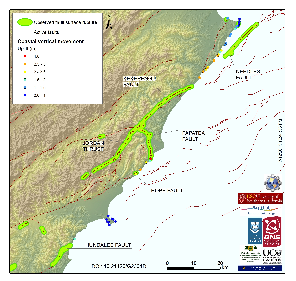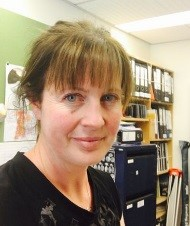
Coastal uplift along the North Canterbury-Marlborough coast- results from the coastal survey team
Extensive coastal uplift occurred during the Nov 14 2016 Kaikoura earthquake. The uplift occurred almost instantaneously – all during the two minutes of shaking caused by the earthquake.
Following the earthquake, a team of scientists from GNS Science and the University of Canterbury headed out into the impacted area to survey and record the amount of coastal uplift that occurred. Knowing the amount and pattern of uplift helps us understand aspects of the earthquake such as how much movement occurred across faults that cut across the coastline, and the presence or absence of offshore faults that also moved in the earthquake. Studying the uplift in the recent earthquake can also help us understand more about earthquakes that occurred in the past. For example, we can compare the amount of uplift that occurred in November 2016 earthquake with tectonic uplift recorded by uplifted marine platforms that were thrust out of the sea by earthquakes many thousands of years ago.
Our survey of coastal uplift showed that most of the coastline from Oaro to Lake Grassmere uplifted, that’s about 110 km of coastal uplift. The uplift varies along the coastline is broadly controlled by where faults ruptured the ground surface during the earthquake. The following paragraphs describe the pattern of coastal uplift from south to north along the coast.
Coastal uplift begins immediately north of where the Hundalee Fault crosses the coastline at Oaro. We observed the uplift from our helicopter surveys and also measured a point near Goose Bay where we recorded about 1.6 m of uplift. This amount of uplift is fairly steady along the coast toward Kaikoura. We measured a lot of points around the Kaikoura Peninsula and recorded about 0.8 – 1 m of uplift, which is consistent with the tide gauge there, which uplifted 0.95 m during the earthquake.
It was difficult to tell if uplift had occurred along the steep gravel beaches between Kaikoura Peninsula and the Hapuku River, but north of the Hapuku River uplift increased. Around Halfmoon Bay and Ohau Stream the uplift was measured at 2-3 m. The Hope Fault comes across the coastline near Halfmoon Bay and there was a small amount of surface rupture on the fault but the amount of uplift either side of the fault did not vary substantially. Just north of Waipapa Bay, two strands of the Papatea Fault cut across the coastline and the block in between these two fault strands was dramatically pushed up about 4.8 – 5 m high. This is the greatest amount of uplift recorded in this earthquake.
North of the Papatea Fault there appeared to be very little coastal uplift. Uplift increased markedly just north of where the Kekerengu Fault crosses the coastline. Uplift of around 2.5 – 3 m was measured at Needles Point, Ward Beach and Chancet Rocks. Between Chancet Rocks and Cape Campbell the amount of coastal uplift gradually decreased, there were a couple of sharp ~0.5 m steps where minor fault ruptures cut across the coastline. Around the corner from Cape Campbell, uplift was still moderate (~1 m) at Marfells Beach.
We noticed big changes in the coastal landscape each time we revisited locations, the uplifted seaweeds are quickly bleaching and falling off the rocks, and new hightide and storm beach lines are being established on the uplifted beach faces. This has been a phenomenal tectonic event and is causing numerous problems for local residents, fishermen, boat operators and other coastal users whose coastline has shifted so suddenly. We are working closely with other scientists to build up a complete understanding of the earthquake, and also keeping in touch with our marine biology colleagues at the University of Canterbury who are working hard to understand the consequences and biological shifts that will be seen in the marine environment.
Written by Kate Clark Earthquake Geologist k.clark@gns.cri.nz



